
The hard clam, also known as a quahog, round clam or hard-shellclam, is an edible marine bivalve mollusk that is native to the eastern shores of North America and Central America from Prince Edward Island to the Yucatán Peninsula. It is one of many unrelated edible bivalves that in the United States are frequently referred to simply as clams, as in the expression "clam digging". Older literature sources may use the systematic name Venus mercenaria; this species is in the family Veneridae, the venus clams.

Carcinus maenas is a common littoral crab. It is known by different names around the world. In the British Isles, it is generally referred to as the shore crab, or green shore crab. In North America and South Africa, it bears the name green crab or European green crab. In Australia and New Zealand, it is referred to as either the European green crab or European shore crab.
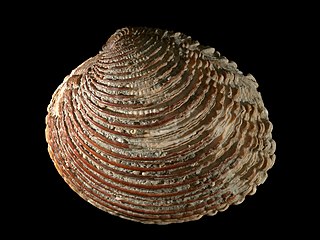
The Veneridae or venerids, common name: venus clams, are a very large family of minute to large, saltwater clams, marine bivalve molluscs. Over 500 living species of venerid bivalves are known, most of which are edible, and many of which are exploited as food sources.

Venus is a genus of small to large saltwater clams in the family Veneridae, which is sometimes known as the Venus clams and their relatives. These are marine bivalve molluscs.
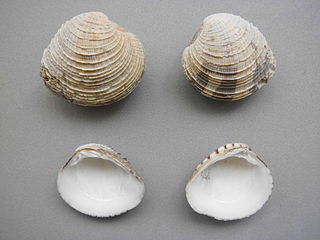
Chione cancellata, is a species of medium-sized saltwater clam, a marine bivalve mollusc in the family Veneridae, the venus clams.

Venerupis philippinarum is an edible species of saltwater clam in the family Veneridae, the Venus clams.

Leukoma is a genus of saltwater clams, marine bivalve molluscs in the family Veneridae, the Venus clams. This genus of bivalves has been exploited by humans since prehistory; for example, the Chumash peoples of California harvested this genus from Morro Bay in approximately 1000 AD.

Meretrix lyrata, the lyrate Asiatic hard clam, also known simply as the hard clam, is an edible saltwater clam, a marine bivalve mollusc in the family Veneridae, the Venus clams.
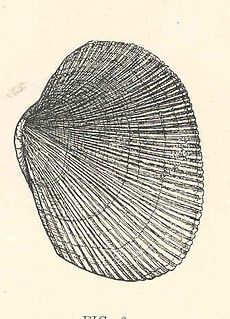
Leukoma staminea, commonly known as the Pacific littleneck clam, the littleneck clam, the rock cockle, the hardshell clam, the Tomales Bay cockle, the rock clam or the ribbed carpet shell, is a species of bivalve mollusc in the family Veneridae. This species of mollusc was exploited by early humans in North America; for example, the Chumash peoples of Central California harvested these clams in Morro Bay approximately 1,000 years ago, and the distinctive shells form middens near their settlements.
Saxidomus, common name the "Washington clams", is a genus of large edible saltwater clams, marine bivalve mollusks in the family Veneridae, the Venus clams.
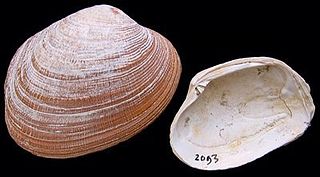
The grooved carpet shell, or Palourde clam, Ruditapes decussatus, or Venerupis decussatus, is a clam in the family Veneridae. It is distributed worldwide and due to its ecological and economic interest has been proposed as a bioindicator.
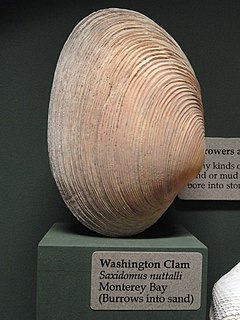
Saxidomus nuttalli is a species of large edible saltwater clam, a marine bivalve mollusk in the family Veneridae, the venus clams. Common names include California butterclam and Washington clam.

Chamelea is a genus of small saltwater clams, marine bivalve molluscs in the family Veneridae, the venus clams.

Petricolaria pholadiformis, common names false angelwing, or false angel wing (US), and American piddock (UK), is a species of saltwater clam, a marine bivalve mollusk in the family Veneridae, the Venus clams.

Periglypta is a genus of bivalves in the family Veneridae.
Ventricolaria is a genus of saltwater clams, marine bivalve molluscs in the family Veneridae, the venus clams.
Macrocallista is a genus of saltwater clams, marine bivalve mollusks in the family Veneridae, the Venus clams.
Parastarte triquetra, or the brown gem clam, is a species of bivalve mollusc in the family Veneridae. It can be found along the Atlantic coast of North America, ranging from Florida to the West Indies.

Saxidomus gigantea is a large, edible saltwater clam, a marine bivalve mollusk in the family Veneridae, the venus clams. It can be found along the western coast of North America, ranging from the Aleutian Islands to San Francisco Bay. Common names for this clam include butter clam, Washington clam, smooth Washington clam and money shell.
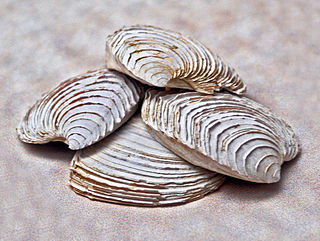
Circomphalus foliaceolamellosus is a species of saltwater clam, a marine bivalve mollusc in the family Veneridae, the venus clams.
















